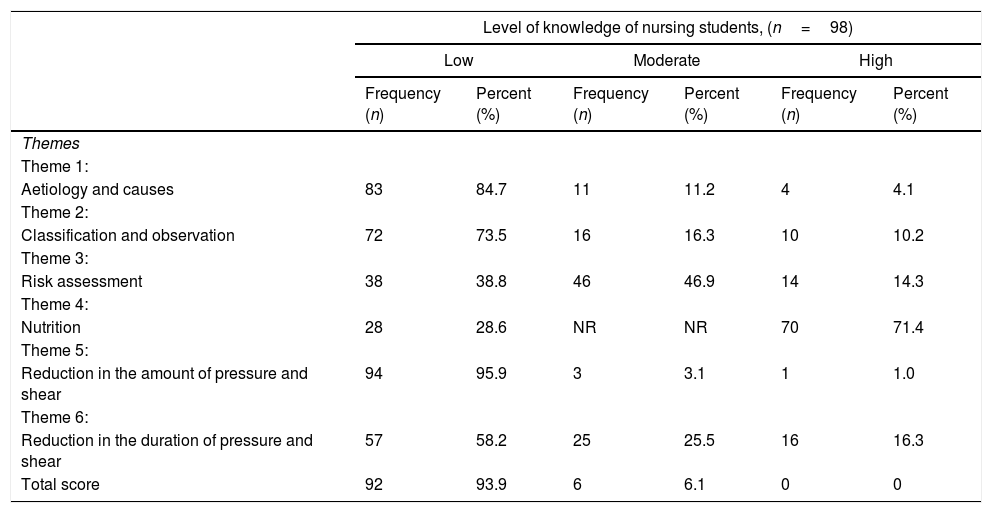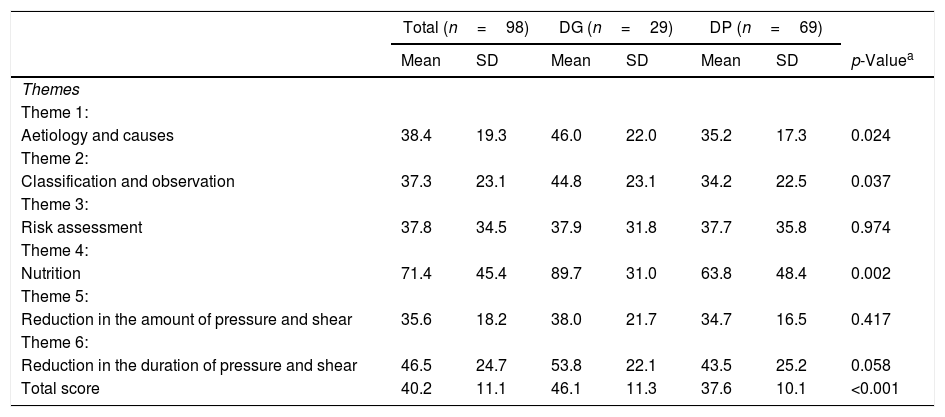Pressure ulcer has been recognized as one of the major causes of morbidity, mortality and a burden to healthcare. Our aim is to compare the level of knowledge regarding pressure ulcer prevention among final year nursing students in one of the Health Campus in Kelantan. This is a cross-sectional study aimed to determine and compare the knowledge of pressure ulcer prevention among the nursing students. The total sample for this study is 108 students. The sampling methods used are purposive sampling methods, i.e. the sample was chosen based on the potentially knowledge about the phenomena studied. Self-administered questionnaire is used to measure the characteristic and knowledge level of sample towards pressure ulcer prevention. Data including descriptive statistic and statistical tests was analyzed using the SPSS version 22.0. Finding of this study was significant with p<0.001 (significant at p<0.05). This indicates the significant differences of pressure ulcer knowledge between both programmes. The degree students have higher knowledge than the diploma students. Therefore, it is evident from this study that higher the level of education, the higher is the knowledge regarding pressure ulcer.
NPUAP (2007)1 defined pressure ulcer as a localized injury to the skin and/or underlying tissue usually over a bony prominence, as a result of pressure, or pressure in combination with shear and/or friction. While EPUAP (1998),2 defined it as an area of localized damage to the skin and underlying tissue caused by pressure, shear, friction and or a combination of these.
Pressure ulcer has been recognized as one of major cause of morbidity, mortality and a burden to healthcare.3 Common comorbidities that can be caused by pressure ulcer are incapacitating chronic and neurodegenerative conditions. Besides, this study also revealed that there was association between pressure ulcer and fatal septic infections such as septicemia.
Review of literaturePressure ulcer is one of the most common problem that occurs across hospital settings. Pressure ulcer also is an indicator of quality of the hospital care4 towards patients who are being hospitalized. The occurrence of pressure ulcer in the hospital must be the main concern among multidisciplinary team such as nurses, physicians, physical therapists, wound experts and educators.5
Internationally, there is an evidence-based guideline of pressure ulcer prevention that have been developed and promoted widely by European Pressure Ulcer Advisory Panel (EPUAP) and National Pressure Ulcer Advisory Panel (NPUAP).6 However, noncompliance to these guidelines are often reported.7 This situation is due to several barriers faced by nurses in practicing while following the recommended guidelines.8–10
ObjectivesTo compare the knowledge of pressure ulcer prevention among final year degree and diploma nursing students in a Health Campus (Fig. 1).
MethodsResearch designThis study is a cross-sectional study aimed to determined and compare the knowledge of pressure ulcer prevention among final year degree and diploma nursing students. The collection of information or data in this study was conducted at one point in time.11
Population and settingThe population of the respondent was undergraduate nursing students. The sample in this study is undergraduate final year nursing students for both degree and diploma nursing programme.
Sampling methodSelection of sample in this study involves the assembly of final year nursing student who have learnt about pressure ulcer in their classroom and are able to practice their knowledge and skills in clinical area. The sampling method used in this study is purposive sampling of nonprobability sampling method i.e. researcher select individuals or sample with potentially knowledge about the phenomena studied (Fig. 2).
InstrumentationInstrument in this study is a self-administered questionnaire which is used to measure the characteristic of sample and knowledge level of sample regarding pressure ulcer prevention. Thus, the questionnaire can be divided into 2 parts. Part 1: Demographic data of respondents and Part 2: Knowledge of pressure ulcer
The second part of questionnaire in this study consisted of Pressure Ulcer Knowledge Assessment Tool (PUKAT). This consists of 26 multiple-choice questions in six different themes.
Ethical considerationThe ethical approval was obtained prior to conducting this study. Permission from programme chairperson of both nursing programme was taken.
Data collection methodsRespondents that fulfilled the inclusion criteria of sample had been approached. Informed consent was obtained before the survey. Respondents who were willing to participate was given 30min to complete the self-administered questionnaire. The data was analyzed. Time frame for data collection started from December 2013 to January 2014.
Data analysisThe Statistical Package for the social Sciences Version 22.0 (SPSS v 22) for Windows was used for data entry, storage, and retrieval. Data including descriptive statistics and statistical tests was done using the SPSS. Independent variables were described by frequency (n) and percentages (%). Mean scores of knowledge were calculated by using descriptive statistics. Differences in background characteristics towards knowledge regarding pressure ulcer prevention between the degree and diploma nursing student was examined by Independent t-test.
ResultsThe data collected were in relative to the research objectives. The fundamental goals that drove the collection of the data and the subsequent data analysis were to gain better insights into knowledge regarding pressure ulcer prevention among nursing students (Table 1).
Distribution of nursing students’ level of knowledge for pressure ulcer prevention by themes.
| Level of knowledge of nursing students, (n=98) | ||||||
|---|---|---|---|---|---|---|
| Low | Moderate | High | ||||
| Frequency (n) | Percent (%) | Frequency (n) | Percent (%) | Frequency (n) | Percent (%) | |
| Themes | ||||||
| Theme 1: | ||||||
| Aetiology and causes | 83 | 84.7 | 11 | 11.2 | 4 | 4.1 |
| Theme 2: | ||||||
| Classification and observation | 72 | 73.5 | 16 | 16.3 | 10 | 10.2 |
| Theme 3: | ||||||
| Risk assessment | 38 | 38.8 | 46 | 46.9 | 14 | 14.3 |
| Theme 4: | ||||||
| Nutrition | 28 | 28.6 | NR | NR | 70 | 71.4 |
| Theme 5: | ||||||
| Reduction in the amount of pressure and shear | 94 | 95.9 | 3 | 3.1 | 1 | 1.0 |
| Theme 6: | ||||||
| Reduction in the duration of pressure and shear | 57 | 58.2 | 25 | 25.5 | 16 | 16.3 |
| Total score | 92 | 93.9 | 6 | 6.1 | 0 | 0 |
NR, not relevant since this question have two levels only.
Table 2 shows the pressure ulcer mean knowledge of degree and diploma nursing students. The mean knowledge score for the students (n=98) was 40.2%. While for each degree and diploma programme, students mean knowledge score were 46.1% and 37.6% respectively. The p-value for mean differences of knowledge regarding pressure ulcer between these two groups was p<0.001. Thus, null hypothesis was rejected, and the result was significant. In other words, there was significant difference of mean knowledge scores between degree and diploma students. The highest scores were in themes ‘nutrition’ (71.4%) and ‘reduction in the duration of pressure and shear’ (46.5%). The lowest scores were in themes ‘reduction in the amount of pressure and shear’ (35.6%) and ‘risk assessment’ (37.3%). Degree students had significantly (p<0.05) higher scores than diploma students on themes include ‘aetiology and causes’ (p=0.024), ‘classification and observation’ (p=0.037), ‘nutrition’ (p=0.002).
Pressure ulcer knowledge of degree nursing students (DGs) and diploma nursing students (DPs).
| Total (n=98) | DG (n=29) | DP (n=69) | |||||
|---|---|---|---|---|---|---|---|
| Mean | SD | Mean | SD | Mean | SD | p-Valuea | |
| Themes | |||||||
| Theme 1: | |||||||
| Aetiology and causes | 38.4 | 19.3 | 46.0 | 22.0 | 35.2 | 17.3 | 0.024 |
| Theme 2: | |||||||
| Classification and observation | 37.3 | 23.1 | 44.8 | 23.1 | 34.2 | 22.5 | 0.037 |
| Theme 3: | |||||||
| Risk assessment | 37.8 | 34.5 | 37.9 | 31.8 | 37.7 | 35.8 | 0.974 |
| Theme 4: | |||||||
| Nutrition | 71.4 | 45.4 | 89.7 | 31.0 | 63.8 | 48.4 | 0.002 |
| Theme 5: | |||||||
| Reduction in the amount of pressure and shear | 35.6 | 18.2 | 38.0 | 21.7 | 34.7 | 16.5 | 0.417 |
| Theme 6: | |||||||
| Reduction in the duration of pressure and shear | 46.5 | 24.7 | 53.8 | 22.1 | 43.5 | 25.2 | 0.058 |
| Total score | 40.2 | 11.1 | 46.1 | 11.3 | 37.6 | 10.1 | <0.001 |
aStudent's t-test, significant at p<0.05.
Other than differences in mean of pressure ulcer knowledge among students from both programme, learning sources and self-perceptions of students’ knowledge was also analyzed to identify if there is significant difference between these two demographic data and level of knowledge. However, there is no significant difference between these demographic data and level of knowledge.
One hundred and eight of questionnaires were distributed to nursing students from both degree and diploma nursing programme. Overall questionnaire response rate was 97% (105/108) of which 93% (98/105) were valid responses for analysis and 7% (7/105) were not valid for analysis. Researcher failed to set 100% of respondents due to non-return and missing questionnaire where respondents did not fully complete the questionnaire.
DiscussionThe findings are also consistent with the current studies done by Qaddumi and Khawaldeh (2014)12 which found that Jordanian nurses (N=141) had insufficient knowledge with means scores 10.84 out of 26 (SD=2.3). Mwebaza et al. (2014)13 also found low level of knowledge about pressure ulcer among Ugandan registered nurses (N=56) in a teaching hospital. The study findings reflected that nursing students were not equipped with adequate knowledge of pressure ulcer prevention. These findings highlighted that lack of knowledge regarding pressure ulcer prevention may lead to increases incidence of pressure ulcer in the hospital. As a result, patients’ expectation to get a quality care from staff nurses is declining. Gunningberg et al. (2013),14 Etafa et al. (2018)15 suggested that Nursing students must be urged to improve and gain more knowledge. This is because they are pre-registered nurses and will graduate as fresh nursing students later. Findings in this study were also consistent with findings of studies done among registered nurses.16
Finding of this study was significant with p<0.001 (significant at p<0.05). This indicates the significant differences of pressure ulcer knowledge between both programmes. As degree nursing students had higher knowledge than diploma nursing students, then it shows that the higher the education, the higher the knowledge.
Conflict of interestsThe authors declare no conflict of interest.
Peer-review under responsibility of the scientific committee of the 3rd International Conference on Healthcare and Allied Sciences (2019). Full-text and the content of it is under responsibility of authors of the article.












